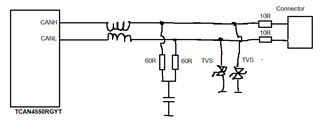Hi,
should we expect any issues, if the line resitance on CAN_H and CAN_L lines is between 3-10 ohms?
This will also increase overall termination resitistance and it will be higer than upper limit of 130 ohm.
What is your experience here?
BR

This thread has been locked.
If you have a related question, please click the "Ask a related question" button in the top right corner. The newly created question will be automatically linked to this question.
Hi,
should we expect any issues, if the line resitance on CAN_H and CAN_L lines is between 3-10 ohms?
This will also increase overall termination resitistance and it will be higer than upper limit of 130 ohm.
What is your experience here?
BR

Hi Josko,
I don't recommend including any series resistance for CAN connections. Such resistance can significantly attenuate the signal at the far end of the network due to the relatively high current that passes through the cables during a dominant state. If series protection is needed from some blocking device, I would recommend a more complex solution such a PTC fuse with low inactive resistance. Generally the high reliability ratings of CAN transceivers allows a system to work without current limiting series components.
Let me know if you have any more questions.
Regards,
Eric Schott
Hi Eric,
thanks on your quick response and for the PTC hint.
So if this protection would be provided for TCAN4550, it should have at least 42V withstand voltage (e.g. 48V PTC version) from TCAN4550 point of view, as CAN bus I/O voltage (CANH, CANL) = +/-42V.
Of course it should fulfil the max. expected electrical overstress on input pins from other device. (e.g. if the max. expected overstress will be 55V, the 60V PTC version should be used).
Do I see this correctly?
Best regards
Josko
Hi Josko,
Yes, the PTC fuse should be selected to survive the expected overvoltage that will be applied. Keep in mind that the voltage across the fuse will not necessarily be the fault voltage, as the transceiver-side will be clamped by the TVS to a voltage greater (for + strikes) than GND. The actual interaction between these protection devices will vary with time (and temperature), so there's not a simple rule for valuing these.
I will note that PTC fuses are useful for prolonged shorts to fault voltages above the transceiver's abs max rating as they take time to become active. In the circuit above, they will mostly be used to protect the TVS from overheating. The TVS diode is the main protection for overvoltage for short-term faults. This is sufficient for most applications that do not anticipate long, high voltage fault conditions.
You may also consider the use of the Q1 qualified version of this transceiver. TCAN4550-Q1 features +-58V bus fault tolerance.
Regards,
Eric Schott